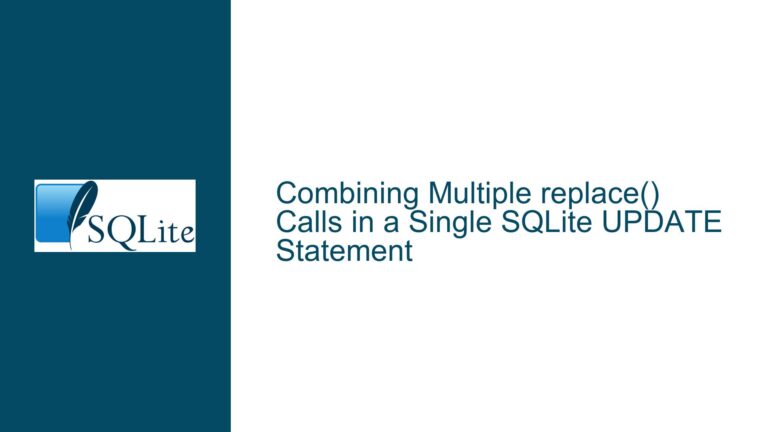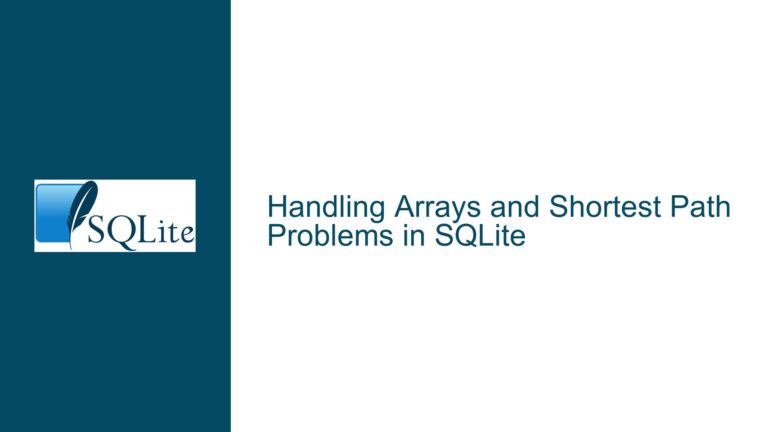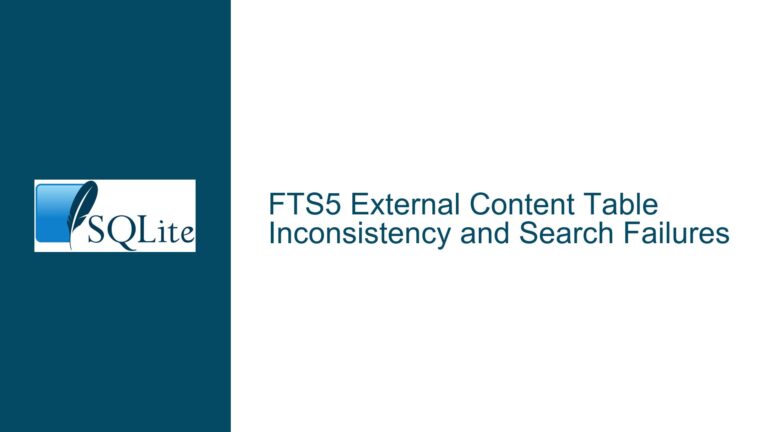Handling Millisecond-Precision Unix Timestamps in SQLite
Issue Overview: The Challenge of Millisecond-Precision Unix Timestamps in SQLite
Working with Unix timestamps in SQLite, particularly when millisecond precision is required, presents several challenges. The primary issue stems from SQLite’s native date and time functions, which are designed to handle timestamps with second-level precision. While SQLite does provide mechanisms to achieve millisecond precision, these methods are often cumbersome, unintuitive, and prone to errors due to the use of "magic numbers" and complex arithmetic operations.
The core of the problem lies in the fact that SQLite’s built-in unixepoch() function returns the number of seconds since the Unix epoch (1970-01-01 00:00:00 UTC). However, many modern applications, particularly those interfacing with JavaScript or requiring high-resolution timestamps for auditing or debugging purposes, need millisecond precision. This precision is crucial for accurately tracking events in write-heavy tables, debugging race conditions, or integrating with systems that use millisecond-based timestamps, such as JavaScript’s Date object.
Currently, achieving millisecond precision in SQLite requires convoluted workarounds. For example, one common method involves using the julianday() function, which returns the Julian day number as a floating-point value. By subtracting the Julian day number corresponding to the Unix epoch (2440587.5) and multiplying by the number of seconds in a day (86400.0), one can derive the number of seconds since the Unix epoch with fractional seconds representing milliseconds. However, this approach is not only verbose but also introduces potential for error due to the use of hard-coded constants like 2440587.5 and 86400.0. Additionally, the resulting floating-point value is not ideal for storage or comparison, often requiring further manipulation to convert it into an integer representing milliseconds.
Another approach involves using the strftime() function with the %f format specifier, which returns fractional seconds. However, this method also requires additional arithmetic to combine the integer seconds and fractional milliseconds into a single millisecond-precision timestamp. Both methods are less than ideal, leading to queries that are difficult to read, maintain, and explain during code reviews.
Possible Causes: Why Millisecond Precision is Problematic in SQLite
The root cause of the difficulty in handling millisecond-precision timestamps in SQLite lies in the database’s design philosophy and its historical focus on simplicity and lightweight operation. SQLite’s date and time functions were originally designed to handle common use cases with second-level precision, which was sufficient for most applications at the time. However, as the demands of modern applications have evolved, the need for higher precision has become more pronounced.
One of the key limitations is the lack of a built-in function that directly returns the number of milliseconds since the Unix epoch. While SQLite provides the unixepoch() function for second-level precision, there is no equivalent for milliseconds. This forces developers to resort to workarounds that involve multiple steps and complex arithmetic, increasing the likelihood of errors and reducing code readability.
Another contributing factor is the way SQLite handles date and time internally. SQLite stores dates and times as either text strings in ISO-8601 format, floating-point Julian day numbers, or integer Unix timestamps. While the Julian day format supports fractional seconds, it is not intuitive for developers who are accustomed to working with Unix timestamps. The lack of a direct mechanism to convert between these formats with millisecond precision further complicates the issue.
Additionally, SQLite’s reliance on the underlying operating system’s time functions can introduce variability in the precision of timestamps. While most modern systems provide millisecond or even microsecond precision, SQLite’s abstraction layer does not consistently expose this precision to the user. This can lead to inconsistencies when working with timestamps across different platforms or environments.
Troubleshooting Steps, Solutions & Fixes: Achieving Millisecond Precision in SQLite
To address the challenges of working with millisecond-precision Unix timestamps in SQLite, several approaches can be taken. These range from using existing functions in creative ways to proposing new functionality that simplifies the process. Below, we explore these solutions in detail.
Using Existing Functions with Arithmetic
The most common workaround involves using the julianday() function to calculate the number of seconds since the Unix epoch with fractional precision. The formula for this is:
SELECT (julianday('now') - 2440587.5) * 86400.0;
This query returns the number of seconds since the Unix epoch, including fractional seconds representing milliseconds. To convert this into an integer representing milliseconds, you can multiply by 1000 and cast the result to an integer:
SELECT CAST((julianday('now') - 2440587.5) * 86400.0 * 1000 AS INTEGER);
While this approach works, it has several drawbacks. The use of hard-coded constants like 2440587.5 and 86400.0 makes the query difficult to read and maintain. Additionally, the need to perform multiple arithmetic operations increases the risk of errors.
Using strftime() with Fractional Seconds
Another approach involves using the strftime() function with the %f format specifier, which returns fractional seconds. For example:
SELECT strftime('%s', 'now') || substr(strftime('%f', 'now'), -3);
This query concatenates the integer seconds since the Unix epoch with the fractional seconds, resulting in a string representation of the timestamp in milliseconds. While this method avoids the use of hard-coded constants, it still requires string manipulation and is less intuitive than a dedicated function.
Proposed Solution: Adding unixepoch_ms() Function
To simplify the process of working with millisecond-precision timestamps, a new function, unixepoch_ms(), could be added to SQLite. This function would return the number of milliseconds since the Unix epoch as an integer, eliminating the need for complex arithmetic or string manipulation. For example:
SELECT unixepoch_ms();
This function would provide a straightforward and intuitive way to obtain millisecond-precision timestamps, making it easier to integrate with systems that require such precision, such as JavaScript or high-resolution logging systems.
Proposed Solution: Adding subsecond Modifier
Another proposed solution is the addition of a subsecond modifier to existing date and time functions. This modifier would enable subsecond precision in functions like unixepoch(), datetime(), and time(). For example:
SELECT unixepoch('subsec');
This query would return the number of seconds since the Unix epoch as a floating-point value, including fractional seconds representing milliseconds. This approach has the advantage of integrating seamlessly with existing functions and maintaining consistency with SQLite’s design philosophy.
Storage Considerations
When storing millisecond-precision timestamps in SQLite, it is important to consider the storage format. Storing timestamps as integers representing milliseconds since the Unix epoch is more space-efficient than using floating-point Julian day numbers or ISO-8601 strings. For example, a table storing timestamps as integers would use less disk space and allow for faster comparisons and sorting.
Conclusion
While SQLite does not currently provide a built-in function for millisecond-precision Unix timestamps, several workarounds exist. These include using julianday() with arithmetic operations, strftime() with fractional seconds, or proposing new functionality like unixepoch_ms() or the subsecond modifier. Each approach has its trade-offs, but the addition of a dedicated function or modifier would significantly simplify the process and improve code readability and maintainability. Until such functionality is added, developers must carefully weigh the pros and cons of each method and choose the one that best fits their application’s needs.






